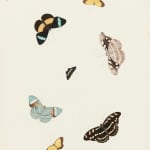Nicolaas Struyck (1686-1769)
Little is known about the mathematician Nicolaas Struyck’s childhood and education.[1] He was born on 21 May 1686 in Amsterdam as the son of the goldsmith Nicolaas Struyck Nicolaaszoon, a faithful member of the Lutheran church. As a little boy he went out with his father catching butterflies. Soon Struyck was in contact with collectors of natural history specimens and assembled a modest collection. By 1718, Struyck had produced six substantial folios with insect drawings. Later in life he was to write that “formerly, insects were my favorite pastime”. Struyck never married and died in Amsterdam in 1769.
At some point, Struyck’s love of natural history morphed into a passion for mathematics. In the field of mathematic he remained a collector: instead of chasing butterflies, he collected empirical data with the aim to discover law-like patterns. The curiosities and natural history specimens in Dutch collector’s cabinets of the late seventeenth century were after all perceived as a small-scale reflection of the world. Struyck started his mathematical work around 1712, when he was 26 years old. Like many beginning mathematicians at the time, he first performed calculations of solar and lunar eclipses. In his Uytreekening der kanssen in het speelen (Calculation of Chances in Games) published in 1716, Struyck displayed his interest in probability calculus. He continued his research into comets to the end of his life. After the publication of his Inleiding (Introduction) in 1740 he carried on tirelessly. The many references to books and papers in foreign journals show that he read profusely and carried on correspondence with colleagues in many countries. However, since his books were published in Dutch, Struyck never received international recognition.
All Struyck’s drawings have the same contemporary black and gold ruled beige card mounts, so-called Seba mounts. Three title pages with Struyck’s signature, dated 1715 and 1719, also support the idea that these sheets originated from albums. The 1719 title page bears the inscription Verschyden, Uytlansche Insecten, geteekent na het Cabinet van d’Hn. Seba, J. ten Kate, &c., versamelt door N. Struyck, junior, 1719, suggesting the drawings were executed after insects in the cabinet of Albertus Seba and others.[2]
Around 1700, East-Frisian born Albertus Seba (1665-1736) opened a pharmacy near the Amsterdam harbor.[3] Seba delivered drugs to the V.O.C. ships departing to the Far East, asking sailors and ship surgeons to bring back exotic plants and animals used for drug preparation. Seba also started to collect snakes, birds, insects and shells bought from, or traded with, the sailors. From 1711 on, he provided drugs to the St. Petersburg court. After Seba promoted his curiosa to the head-physician to the tsar, Robert Arskine, Peter the Great bought the complete collection for 15,000 guilders in 1716. Seven months later, seventeen trunks arrived in Saint Petersburg. With Seba as an intermediary, the famous botanist Frederik Ruysch also sold his collection to the tsar. From 1728 until 1830, both collections were exhibited in the tsar’s Kunstkammer in St. Petersburg.
After the sale of his first cabinet, Seba immediately began forming an even more extensive one. He was able to take advantage of Amsterdam’s preeminent position in overseas trade to collect exotic specimens and had numerous foreign contacts in Ceylon, Virginia, Arabia, Greenland and elsewhere. While the second cabinet is documented in the Thesaurus and some specimens from both cabinets survive in Saint Petersburg and Paris, there is no pictorial record of the first cabinet. Possibly, Seba commissioned Struyck to draw all the specimens before shipping the collection to Russia. Struyck’s drawings may be the sole survivors of a long lost extensive pictorial record of specimens of Seba’s famous natural history cabinet. These drawings were most likely included in the six folios with 271 drawings of insects and butterflies, birds, shells and plants—each carefully mounted—in Struyck’s possession.[4]. The undertaking of such an elaborate project can only have been done for a wealthy patron interested in science and nature. It would have been a long-term commission, begun well in advance of the 1719 date on the title page.
[1] Huib J. Zuidervaart, Early quantification of scientific knowledge: Nicolaas Struyck (1686-1769), as a collector of empirical data, p 127
[2] National History sale, Sotheby’s London, 8 November 2000, lot 155 (10 drawings)
[3] Zuidervaart, op.cit., p 127, fn. 10 Cf. Smit et al., Hendrik Engel’s Alphabetical List, no. 1485
[4] Hermann August Hagen, Biblioteca Entomologica. Die Litteratur über das ganze Gebiet der Entomologie, bis zum Jahre 1862, Leipzig 1862-1863, Vol. II, p. 394
Provenance
RandallLucien Goldschmidt (1912-1992), New York, 1970s
George and Maida Abrams, Boston
Johnny van Haeften, London, 2000
Bonhams, London, 20 April 2005, lot 142
Peter Tillou, London, 2005
Private collection, United Kingdom
Private collection, The Netherlands
Literature
T.O. Weigel, 1862, catalogue XIIIHermann August Hagen, Biblioteca Entomologica. Die Litteratur über das ganze Gebiet der Entomologie, bis zum Jahre 1862, Leipzig 1862-1863, Vol. II, p. 394



